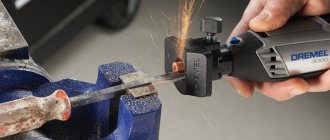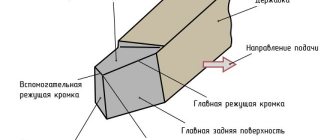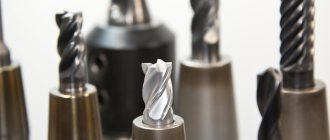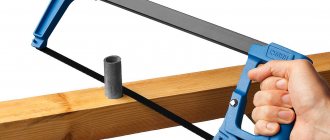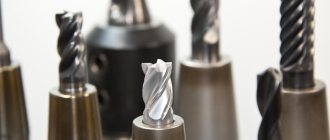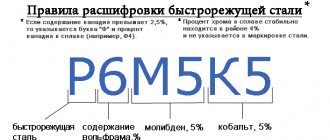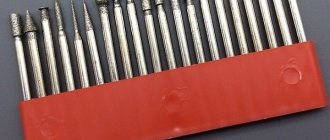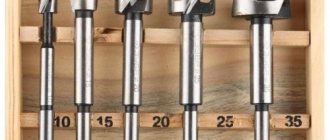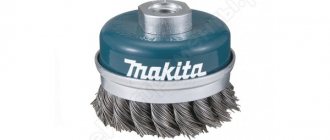Roller cutter design and its advantages
Roller cutters are a cutting tool consisting of two parts: a shank rod, which is fixed in the drill chuck; working head made of durable material.
Metal cutters are also called burrs. Their advantage is the ability to process hard-to-reach places on workpieces made of different materials. Their difference from a milling cutter is that it is impossible to create certain shapes using a cutter; it belongs to the auxiliary tools of final processing. Features of the roller cutter are:
- the ability to use it in hand tools;
- in the abrasive structure of the working surface;
- higher product processing speed – up to 60 thousand rpm;
- high quality grinding.
What is a roller cutter and where is it used?
A roller cutter (burr, roller bit) is a tool whose history goes back more than a dozen, and perhaps more than one hundred years; there is no exact data on this matter. The design of this tool includes two main elements: a shank, with which the cutter is fixed in the chuck of the equipment used, and a working head, which performs the main work of grinding various materials. During processing, the cutter is given rotation, the speed of which can reach up to 60,000 rpm.
Modern manufacturers produce cutters made of different materials with working heads of various sizes and shapes. This diversity allows you to select a tool to solve specific technological problems. When making such a choice, they are guided primarily by the characteristics of the material from which the product being processed is made, as well as the geometric parameters of the latter.
Metal burrs with extended shank
Cutters for metal and other materials are actively used in many areas, including mechanical engineering, construction, automotive, mining, medicine, jewelry, etc. Using such a tool, you can effectively process products made of various metals, wood, stone, glass, etc. plastic.
You cannot do without cutters when producing plastic windows (with the help of such a tool the joints are cleaned). In the mining industry, it is practiced to use large-diameter stone cutters, the working part of which has carbide teeth installed. In jewelry and in the manufacture of decorative elements, small cutters are used to not only process small parts, but also apply inscriptions and patterns to the surface of products.
Engraving work with a mini cutter on ceramics
Dentistry is another area where cutters are used very actively. It is this kind of tool that is the working part of the well-known drill; it is also used in the manufacture of dentures. In everyday life, cutters installed in the chuck of a conventional electric drill are also used quite often. Using them, home craftsmen solve many problems related to home renovation and maintaining it in proper condition.
Using cutters, correctly selecting their shape and material of manufacture in accordance with the tasks to be solved, you can make a smooth and neat hole in glass, ceramic tiles, stone, brick and wooden products, clean welds efficiently, process hard-to-reach places, something no other tool can handle.
Areas of use
It is known that rollers have been used for a long time. Their functions are so diverse that there is practically no economic sphere where they are not used:
Examples of using different types of cutters
- in mining, burrs with large diameters and high-strength teeth capable of crushing stone have become widespread;
- an important function of the nozzles is to process matrices;
- in the production of plastic windows, they are necessary when cleaning the seams of window profiles;
- engraving represents a wide area for the use of small-sized attachments;
- in the treatment and prosthetics of teeth one cannot do without burrs;
- in the construction industry they can be used in installation work with any material;
- in welding operations - for cleaning internal, hard-to-reach seams;
- a set of metal cutters is a must-have in every car enthusiast’s garage;
- Without drill attachments, minor repair work in the house is impossible.
Types of rollers
There is a wide range of burrs on the market that differ in size or configuration. This variety allows you to choose the right device depending on the purpose of use and the structure of the material being processed.
Cylindrical cutters come with a smooth, serrated or spherical end. They are used to enlarge holes at a specific angle. They are also convenient for sharpening tools, such as screwdrivers.
Shapes of working heads of cutters
The spherical nozzle allows you to grind the weld from the inside at an angle of 90 degrees or less. With its help, you can also clean out small metal defects on parts or remove paint smudges, especially with limited access to the surface.
The oval shape of a metal cutter is something between cylindrical and spherical. It is designed for cleaning the end of the workpiece and internal cavities of a certain shape.
The parabolic head of a burr can be rounded or pointed. The rounded head is useful when forming grooves or cleaning recesses. It is used when it is necessary to clean, for example, an oil line. The sharp parabola removes burrs from the edges of gears, as well as internal welds in tight spaces.
A drill cutter in the shape of a flame tongue is the most versatile, as it combines the advantages of a parabola and a barrel-shaped oval. It is effective when processing the most difficult surfaces.
A countersink is a special burr for metal, used in processing a cylindrical or conical hole. It is indispensable for forming internal threads or removing an even chamfer from the edge of a tapered hole.
What is a cutter
A roller cutter for a metal drill (cone bit, burr) is a device that appeared quite a long time ago. It consists of two parts: a fixing tail and a working element. The cutter can rotate at speeds of up to 60,000 rpm during operation.
Manufacturers today offer devices made of different materials and with working elements of various shapes and dimensions. Such a wide selection makes it possible to select devices for many technological tasks. When choosing, as a rule, they are guided by the parameters of the material that was used to create the tool being processed, as well as geometric characteristics.
Burrs are used in many areas, which include construction, mining, mechanical engineering, jewelry, medicine, etc. Using this device, you can effectively and efficiently process products not only from metal alloys, but also from glass, stone, wood, etc. plastics.
Roller cutters are also used in the manufacture of PVC windows . At mining enterprises, devices for stone of increased diameter and a working element with teeth made of hard alloy are used. Jewelers use these products to produce decorative parts and apply patterns and inscriptions to products.
Dentistry is another area where cutters are often used. This device is the main component of the famous drill. At home, burrs are installed in ordinary electric drills. Using them, home craftsmen solve a large number of household problems.
Using burrs, you can make a neat and even hole in ceramics, glass, brick, stone and wood products, make a good cleanup of welding seams and process hard-to-reach areas.
Material quality
According to their design, burrs are single-, double- and triple-cone. Metal cutters also differ in the type of material chosen for their production or further spraying.
Carbon steel tools are the most common. Most often they are equipped with a drill and are used for household needs:
- processing of sharp edges of parts;
- creating recesses on them;
- expanding the diameter or obtaining new holes.
These cutters can be used to work on wooden surfaces or metal. Their main advantage is their affordable cost.
The use of a burr depending on the type of cut
Diamond cutters can be equipped with both a hand drill and a machine. They are intended:
- for working with fragile materials – glass or ceramics;
- grinding products made of hard metals and alloys that are not amenable to metal burrs;
- for grinding and engraving decorative objects;
- boring small holes.
Diamond cutters provide jewelry precision and high quality.
Set of diamond cutters
Abrasive cones are made by spraying a high-strength powder, most often corundum, onto the head. Due to its high degree of hardness, corundum cutters are widely used in processing a variety of materials:
Corundum cutters
- metal and stone;
- ceramics and glass;
- concrete and brick walls.
Abrasive burrs are distinguished by low prices and fragility. Their service life is shorter than that of metal tools.
In industrial production conditions, when there is a need for stripping materials with high strength, cutters made of hard alloys are used.
They come in different configurations and are characterized by:
- resistance to heat;
- high level of durability;
- complete with high power tools.
Types of tools and features of their design
Roller cutters are produced in various designs, and for their manufacture, as mentioned above, different materials can be used.
By structure, burrs can be:
- single-cone design;
- double-cone;
- three-cone.
The shapes of the head of such a tool can also be varied. Thus, there are cutters with a conical, cylindrical, spherical, oval or semi-oval head. The choice of one type of tool or another depends both on the nature of the technological tasks and on the geometric parameters of the product to be processed.
Shapes of working heads of cutters
Roller cutters also differ in the material they are made of. Depending on this parameter, these could be:
- tools made of carbon steel;
- diamond cutters, the working part of which is coated with diamond chips;
- abrasive rollers, which can also be sprayed onto the working part or made entirely of abrasive material;
- carbide cutters, on the metal shank of which a working head made of carbide is soldered.
Carbon steel burrs Cutters
made from carbon steel are most often used to work in conjunction with an electric drill or screwdriver. These can be either wood cutters for a drill or a tool designed for processing metal products. One of the main advantages of such a burr is its low price.
Carbon steel cutter teeth wear heavily when working with hard metals
Using this metal tool, even at home, you can process recesses of complex configurations, eliminate sharp edges on products, create smooth and neat holes and increase the diameter of existing ones.
Diamond coated cutters
Diamond cutters, which can also be used in conjunction with hand-held power tools, are already a professional tool. It can be used for fine grinding and boring of holes. Such tools demonstrate their effectiveness not only when processing fragile materials such as glass or ceramics, but also when working with high-strength materials where metal cutters are simply powerless.
Professional diamond-coated bits
A diamond cutter is exactly the tool that is equipped with engraving machines, which allow processing the smallest details and applying various patterns and inscriptions to the surface of products. The surface processed using a diamond cutter has a minimal degree of roughness.
Abrasive cutters
From the point of view of application, an abrasive cutter made by spraying is not much different from a diamond-type tool. Due to the high hardness of its working part, the abrasive cutter can be successfully used for processing materials such as metal, plastic, ceramics and glass, concrete, artificial and natural stone, brick, etc. Like the tools of the two previous categories, the abrasive cutter can be used in any shapes and sizes, and can also be used in conjunction with a drill and screwdriver.
Corundum cutters
The working part with which the abrasive cutter is equipped is made by spraying or made entirely of abrasive material, which is most often used electrocorundum. An abrasive roller bit has a low cost, but also lasts significantly less than even a metal tool.
Carbide head cutters
Roller cutters, the working part of which is made of hard alloy, are used primarily in industrial conditions. Carbide cutters, which are equipped with powerful and high-speed power tools, are used for processing materials of high hardness - cast iron, heat-resistant and stainless steel, titanium alloys, etc.
Metal cutters with carbide head
Cones of this particular type are the optimal choice in cases where it is necessary to qualitatively process welded seams. Carbide tools, the working part of which can also have different configurations, are characterized by an exceptionally long service life.
Selection Criteria
In order for the use of a roller cutter to bring the desired effect, when choosing it you must take into account:
- the nature of the work performed;
- properties of the material to be processed;
- dimensions and shape of the product;
- technical characteristics of the tool with which the burr is supplied.
Types of cutters for metal
An indicator of the efficiency of cutters is the cutting of their teeth:
- standard cutting is used for deburring and chamfering;
- rare teeth are used to process parts made of aluminum and copper;
- carbide teeth are used for working with cast iron and stainless steel;
- Ultra-fine cutting provides a high level of polishing.
If you have a whole set of different types of cutters on hand, you can always choose the best option.
Marking of burrs for metal
Terms of use
Previously, attachments were used mainly for household needs in combination with a drill. However, when combined with hand tools, the cutters wear out faster and the quality of their cutting teeth deteriorates. With the development of technology, burrs began to be installed on numerically controlled machines, which makes it possible to clearly regulate the accuracy of the specified parameters during processing:
- chamfer height;
- nozzle inclination angle;
- depth of grooves on the metal;
- bore diameter.
Sharpening a chisel with an abrasive burr
Following a few simple rules will help increase the operating time of cutters when working with hand tools:
- the working head of the cutter must be in close contact with the surface of the part;
- the burr shank should not touch the product;
- strong pressure on the cutter during operation can cause it to overheat and break;
- correct calculation of processing speed will increase its efficiency;
- a special lubricant applied to the working head will reduce the degree of wear;
- Timely replacement of worn tools will protect the drill from damage.
Since the tool is not sharpened or refurbished, following proper use will extend its service life.
How to use burrs correctly
A few decades ago, cutters were used only for processing in combination with hand tools. The development of new materials and the development of technologies have led to manufacturers changing their attitude towards burrs and beginning to use them to equip stationary machines, including those with CNC systems.
Despite the fact that processing using cutters mounted on hand-held power tools is highly effective, it does not create perfectly smooth surfaces. In addition, use in conjunction with hand tools negatively affects the condition of the cutters themselves, whose cutting edges become jagged, which, accordingly, reduces their service life.
The size of the working attachment must correspond to the tool used
Installing cutters on CNC machines allows not only to increase the service life of the tool, but also to significantly improve the quality and accuracy of the processing performed. In particular, when using such equipment, it is possible to accurately maintain such processing parameters as the thickness of the layer of metal being removed, the angle of inclination and depth of the grooves created on the surface of the part, the depth and diameter of the hole being made or bored.
However, if you follow certain rules for processing with cutters using hand-held power tools, you can not only extend the service life of the burr itself, but also minimize its negative impact on the equipment with which it is used.
Let us present these rules.
- The working part of the cutter must be in full contact with the surface being processed, which will improve the quality of the technological operation and its efficiency. In addition, it is necessary to ensure that the metal shank of the tool does not come into contact with the surface of the workpiece, as this can lead to destruction of the junction of the working head and the shank.
- During processing, strong mechanical pressure should not be applied to the cutter. If this requirement is neglected, it may reduce the efficiency of the processing performed and increase the load on the power tool, which will lead to its overheating and, as a result, rapid failure.
- It is very important to choose the right processing speed. This will not only increase the service life of the drill you are using, but will also reduce energy costs. It should be borne in mind that processing using a cutter rotating at high speed allows you to avoid many problematic situations, which, in particular, include the formation of irregularities and burrs on the surface of the workpiece, and jamming of the tool in the material being processed. In addition, using a tool rotating at high speed, corners and grooves can be processed more carefully and accurately.
- The working head of a roller cutter, like any other tool in contact with hard materials, is subject to active wear and abrasion. There are several simple techniques that can reduce the wear rate of the cutter head and extend the service life of the tool. One of these techniques involves the use of a special lubricant, which is periodically applied to the working head of the burr. Lubrication reduces the load on the tool and allows it to glide better over the surface of the workpiece. Another method is that during the processing process the working head of the cutter is immersed from time to time in a special suspension, the basis of which can be wax or synthetic machine oil.
- If you notice that the tool is very worn, immediately replace it with a new one. Using a heavily worn tool to perform processing will not only require significant physical effort, but can also lead to damage to the cutter itself and/or the power tool.
